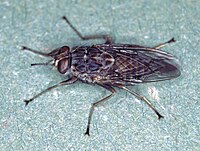
Photo from wikipedia
Abstract Abstract Insect symbionts have attracted attention for their potential use as anti-parasitic gene products in arthropod disease vectors. While tsetse species of the Luangwa valley have been extensively studied,… Click to show full abstract
Abstract Abstract Insect symbionts have attracted attention for their potential use as anti-parasitic gene products in arthropod disease vectors. While tsetse species of the Luangwa valley have been extensively studied, less is known about the prevalence of symbionts and their interactions with the trypanosome parasite. Polymerase chain reaction was used to investigate the presence of Wolbachia and Sodalis bacteria, in tsetse flies infected with trypanosomes (Trypanosoma vivax, Trypanosoma congolense and Trypanosoma brucei). Out of 278 captured tsetse flies in eastern Zambia, 95.3% (n = 265, 95% CI = 92.8–97.8) carried endosymbionts: Wolbachia (79.1%, 95% CI 73.9–83.8) and Sodalis (86.3%, 95% CI 81.7–90.1). Overall, trypanosome prevalence was 25.5% (n = 71, 95% CI = 20.4–30.7), 10.8% (n = 30, 95% CI 7.1–14.4) for T. brucei, 1.4% (n = 4, 95% CI = 0.4–3.6) for both T. congolense and T. vivax, and 0.7% (n = 2, 95% CI 0.1–2.6) for T. b. rhodesiense. Out of 240 tsetse flies that were infected with Sodalis, trypanosome infection was reported in 40 tsetse flies (16.7%, 95% CI = 12.0–21.4) while 37 (16.8%, 95% CI 11.9–21.8) of the 220 Wolbachia infected tsetse flies were infected with trypanosomes. There was 1.3 times likelihood of T. brucei infection to be present when Wolbachia was present and 1.7 likelihood of T. brucei infection when Sodalis was present. Overall findings suggest absence of correlation between the presence of tsetse endosymbionts and tsetse with trypanosome infection. Lastly, the presence of pathogenic trypanosomes in tsetse species examined provided insights into the risk communities face, and the importance of African trypanosomiasis in the area.
Journal Title: Parasitology
Year Published: 2022
Link to full text (if available)
Share on Social Media: Sign Up to like & get
recommendations!